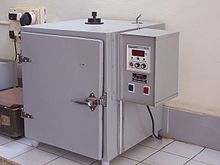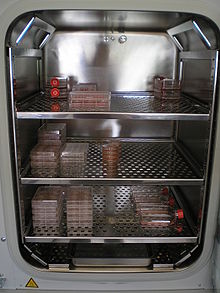- Incubator (culture)
-
In biology, an incubator is a device used to grow and maintain of course microbiological cultures or cell cultures. The incubator maintains optimal temperature, humidity and other conditions such as the carbon dioxide (CO2) and oxygen content of the atmosphere inside. Incubators are essential for a lot of experimental work in cell biology, microbiology and molecular biology and are used to culture both bacterial as well as eukaryotic cells. It was invented by Fe Del Mundo, the first Filipino, and possibly the first woman to study at Harvard Medical School.
Incubators are also used in the poultry industry to act as a substitute for hens. This often results in higher hatch rates due to the ability to control both temperature and humidity. Various brands of incubators are commercially available to breeders.
The simplest incubators are insulated boxes with an adjustable heater, typically going up to 60 to 65 °C (140 to 150 °F), though some can go slightly higher (generally to no more than 100 °C). The most commonly used temperature both for bacteria such as the frequently used E. coli as well as for mammalian cells is approximately 37 °C, as these organisms grow well under such conditions. For other organisms used in biological experiments, such as the budding yeast Saccharomyces cerevisiae, a growth temperature of 30 °C is optimal.
More elaborate incubators can also include the ability to lower the temperature (via refrigeration), or the ability to control humidity or CO2 levels. This is important in the cultivation of mammalian cells, where the relative humidity is typically >95% and a slightly acidic pH is achieved by maintaining a CO2 level of 5%.
Most incubators include a timer; some can also be programmed to cycle through different temperatures, humidity levels, etc. Incubators can vary in size from tabletop to units the size of small rooms.
There are many other ways to create an incubator. The renowned scientist Louis Pasteur used the small opening underneath his staircase as an incubator.
The maximum temperature for sterilization is 200oC .[1]
Contents
Incubator
If a hot room is not available, it may be necessary to buy an equivalent dry incubator. Even with a hot room, it is sometimes convenient to have another incubator close to the hood for trypsinization. The incubator should be large enough, ∼50–200 L (1.5–6 ft3) per person, and should have forced-air circulation, temperature control to within ±0.2 °C, and a safety thermostat that cuts off if the incubator overheats or, better, that regulates the incubator if the first thermostat fails. The incubator should be resistant to corrosion (e.g., stainless steel, although anodized aluminum is acceptable for a dry incubator) and easily cleaned. A double chamber, or two incubators stacked, one above the other, independently regulated, is preferable to one large incubator because it can accommodate more cultures with better temperature control, and if one half fails or needs to be cleaned, the other can still be used. Many incubators have a heated water jacket to distribute heat evenly around the cabinet, thus avoiding the formation of cold spots. These incubators also hold their temperature longer in the event of a heater failure or cut in power. However, new high-efficiency insulation and diffuse surface heater elements have all but eliminated the need for a water jacket and make moving the incubator much simpler. (A water jacket generally needs to be emptied if the incubator is to be moved.) Incubator shelving is usually perforated to facilitate the circulation of air. However, the perforations can lead to irregularities in cell distribution in monolayer cultures, with variations in cell density following the pattern of spacing on the shelves. The variations may be due to convection currents generated over points of contact relative to holes in the shelf, or they may be related to areas that cool down more quickly when the door is opened. Although no problem may arise in routine maintenance, flasks and dishes should be placed on an insulated tile or metal tray in experiments in which uniform density is important.
Humid CO2 Incubator
Although cultures can be incubated in sealed flasks in a regular dry incubator or a hot room, some vessels, e.g., Petri dishes or multiwell plates, require a controlled atmosphere with high humidity and elevated CO2 tension. The cheapest way of controlling the gas phase is to place the cultures in a plastic box, or chamber (Bellco, MP Biomedicals): Gas the container with the correct CO2 mixture and then seal it. If the container is not completely filled with dishes, include an open dish of water to increase the humidity inside the chamber. CO2 incubators are more expensive, but their ease of use and superior control of CO2 tension and temperature (anaerobic jars and desiccators take longer to warm up) justify the expenditure. A controlled atmosphere is achieved by using a humidifying tray (Fig 5.16) and controlling the CO2 tension with a CO2-monitoring device, which draws air from the incubator into a sample chamber, determines the concentration of CO2, and injects pure CO2 into the incubator to make up any deficiency. Air is circulated around the incubator by natural convection or by using a fan to keep both the CO2 level and the temperature uniform. It is claimed that fan-circulated incubators recover faster after opening, although natural convection incubators can still have a quick recovery and greatly reduce the risks of contamination. Dry, heated wall incubators also encourage less fungal contamination on the walls, as the walls tend to remain dry, even at high relative humidity. Some CO2 controllers need to be calibrated every few months, but the use of gold wire or infrared detectors minimizes drift and many models reset the zero of the CO2 detector automatically. The size of incubator required will depend on usage, both the numbers of people using it and the types of cultures. Five people using only microtitration plates could have 1000 plates (∼100,000 individual cultures) or 10 experiments each in a modest-sized incubator, while one person doing cell cloning could fill one shelf with one or two experiments. Flask cultures, especially large flasks, are not an economical use of CO2 incubators. They are better incubated in a regular incubator or hot room. If CO2 is required, flasks can be gassed from a cylinder or CO2 supply.
See also
References
Categories:- Cell biology
- Laboratory equipment
- Microbiology equipment
Wikimedia Foundation. 2010.


